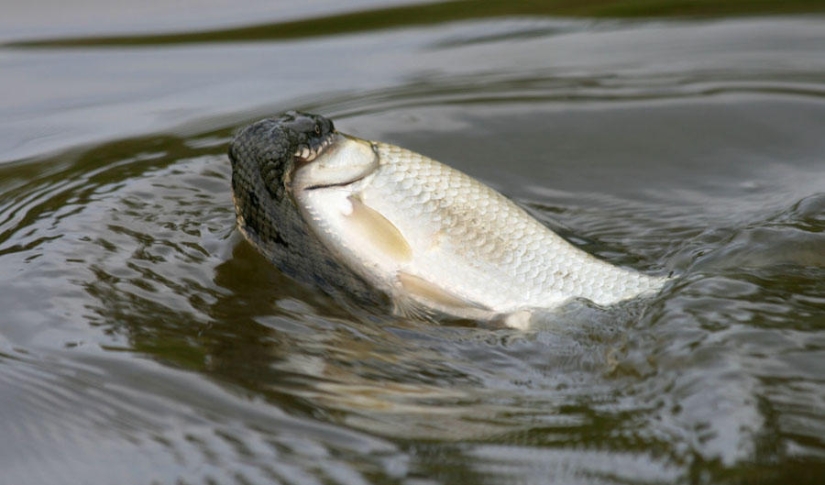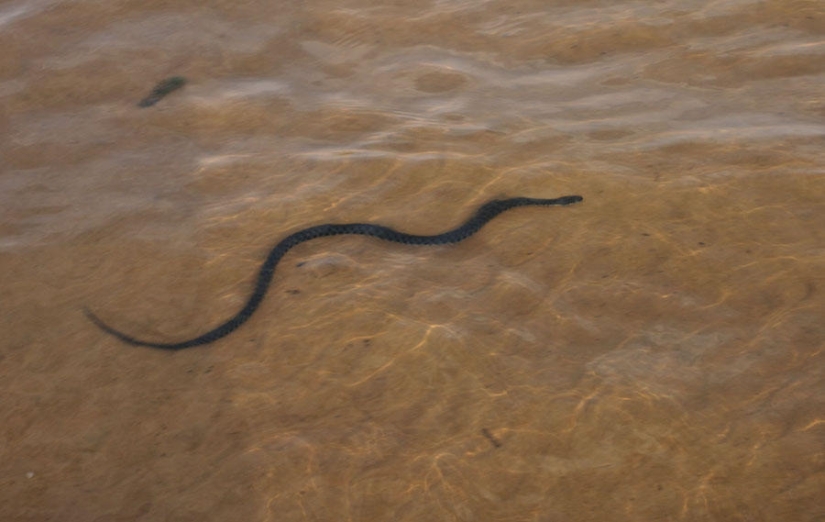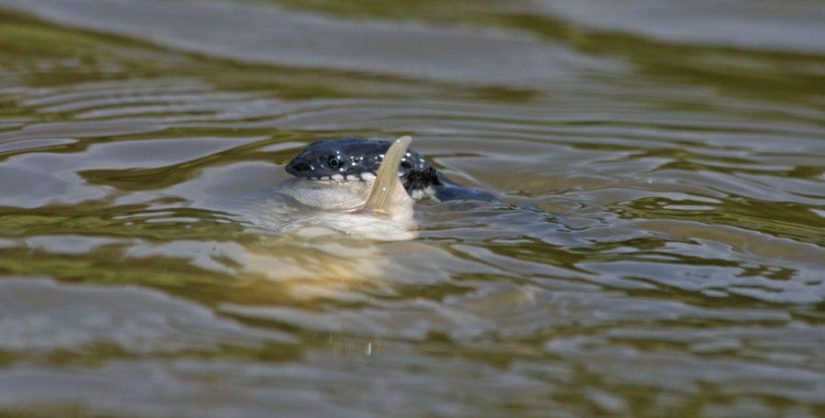Stanislav Shinkarenko writes: “My article about water snakes was published in the November issue of National Geographic. Unfortunately, the format of the “Facts” section did not allow publishing a lot of text and photos, so I will publish the material in full on the blog.”
(Total 14 photos)

Source: Journal/shinkarenkostas

1.

2.
“Are you taking pictures of a viper,” I heard a voice behind me, “Look out so that you don’t bite.”
“No, not a viper, but a snake,” I answered, without looking up from the camera viewfinder and shooting another close-up.
- Yes, vipers are now interbreeding with snakes: they turn out black, and gray, and in a box, and all are terribly poisonous!

3. Something like this happens every time someone sees me catching or photographing water snakes (Natrix tessellata).

4. The notoriety of these snakes is just the fruit of the fear of people who are not familiar with reptiles. Water snakes lack the characteristic sign of a non-venomous snake, familiar to everyone - yellow-orange spots at the back of the head that the common grass snake (Natrix natrix) has. For this reason, unknowing people classify all snakes without such spots as vipers and consider them poisonous and dangerous. Many people divide all legless reptiles into snakes and just "snakes", referring to vipers. So they say: “Is it really or a snake?”.

5. As soon as they don’t call water snakes: “a hybrid of a viper and a snake”, “chess viper”, “chess”. When shouting “chess snake” on the beach, swimmers jump out of the water and wait for the snake to swim away, or until a “dared man” is found and kills the snake with a stick. One often hears the stories of anglers about "meter-long vipers" swimming across rivers or climbing into cages with fish. All these stories are not really related to vipers, they are about water snakes. The specific name of the snake N. tessellata is indeed translated from Latin as chess, but the water viper has nothing to do with vipers. It belongs to the genus (Natrix sp.) like the common snake.

6. For a person, the water one is already harmless. The snake's means of defense are loud hissing and fetid excrement emitted when threatened. Unlike the common water snake, it almost never pretends to be dead.

7. The main food of water snakes is fish, which they catch among aquatic plants, snags or lying in wait at the bottom. The snake cannot swallow the caught prey under water, therefore it rushes to the shore, where it swallows the fish, having previously turned its head towards itself.

8. If the prey is too large, the meal can drag on for an hour or even longer. Some snakes die, not calculating their strength and choosing too large a fish.

9. “The water one is already quite widespread: from southwestern France, the river valley. The Rhine is in the west, the southern border of the range runs along the eastern part of northern Africa (to the Persian Gulf, Pakistan), in the east it occurs to the north-west of China, and the northern limits of the occupied territory pass through the Volga-Kama Territory, ”says candidate of biological sciences, employee Volgograd State University, herpetologist Dmitry Gordeev. “This species belongs to the class of reptiles (Reptilia), the order of snakes (Serpentes), the family of snakes (Colubridae), the genus of real snakes (Natrix) and the species of water snake (Natrix tessellata). The water snake is a relatively large non-venomous snake, like all representatives of this family. Moreover, females, as a rule, are longer than males and can grow up to 1.1 m. Despite its impressive size, it is somewhat smaller than the familiar and easily recognizable common snake, which can reach up to 1.14 m. , more pointed, and there are no yellow-orange spots on the sides of the head. Because of the latter circumstance, it is often confused with such venomous snakes as the common viper and the steppe viper. "Oil on the fire" adds a pattern on the back of a water snake, which vaguely resembles a zigzag stripe of vipers. I repeatedly came across dead snakes, which, apparently, the local population took for poisonous and mercilessly exterminated. On one of the expeditions, I came across a place of "mass execution", where I counted 25 "chess vipers" killed.

10. However, the water snake has a number of external signs by which it can be easily distinguished from poisonous vipers. The head is most recognizable - in vipers it is triangular in shape and most of the scutes (scales) on it are small, while in the water snake it is oval, and all the scutes are large. If you muster up the courage and look into the eyes of a snake, you can see that vipers, like real predators, have a vertical pupil (like a cat), and a snake has a round one. In addition, vipers are much smaller than snakes: the largest common viper reaches a length of up to 0.73 m.

11. The water one already settles near the water: along the banks of rivers and irrigation canals, in flood meadows, where he finds his livelihood. Despite the peaceful nature, he is an active predator. Prefers fish of different species - perch, roach, loach, can even hunt pike. Therefore, scientists call it an ichthyophage. The snake pulls the caught prey ashore, where it eats. Much less frequently, the diet includes frogs and their tadpoles. In the literature there is information about the discovery in the stomach of even a baby of an ordinary viper! The size of the prey can exceed the size of the snake's head, and the movable connection of the lower jaws and some bones associated with them helps to swallow it. Swallowing occurs by alternating movement of the left, then the right half of the lower jaw. This creates the impression that the snake "crawls" on its prey.

12. The active season lasts almost 9 months, they emerge from winter shelters in April. Soon after this, mating begins, then snakes are found in large numbers. One female can lay from 4 to 20 eggs, of which in July, under favorable circumstances, young growth will appear. Reed beds, tree roots, crevices in the substrate, rodent burrows, stumps and snags serve as a refuge for them. They leave for wintering at the end of October in large groups, sometimes together with an ordinary grass snake. Hedgehogs, desman, muskrat, fox, some birds hunt for snakes: osprey, gray heron, kites, serpent eagle, crow, rook and some others.

13. Every time I hear mention of a "terribly poisonous checkerboard", I talk about water snakes, their lifestyle, I try to convince them that these snakes are absolutely not dangerous. But every time I encounter misunderstanding, it’s easier for people to be afraid of the “chess viper” than to admit their belief in rumors and stop killing all snakes that lack the “identification marks” of an ordinary snake.

14.
Keywords: National Geographic | Snakes | Fishing
Post News ArticleRecent articles

In 1910 in Venice tried a Russian noblewoman Maria Tarnovskaya, whom journalists called the "Bloody Countess". On account of this ...

Many biographers of Leonid Brezhnev write that the General Secretary of the CPSU have not experienced particularly warm feelings to ...
Related articles

Despite the constant employment and state care, many Russian rulers were still different hobby. Some like to fish, someone was a ...

We know many stories when a person, forced to protect himself and his loved ones, did incredible things. But among all of them, ...

Earlier we already told you about the 25-year-old beauty Hannah Barron, who likes to catch big fish with her bare hands. But it ...

Many of these foods have become so firmly embedded in our lives that sometimes it seems to us that they grow in packaging right on ...